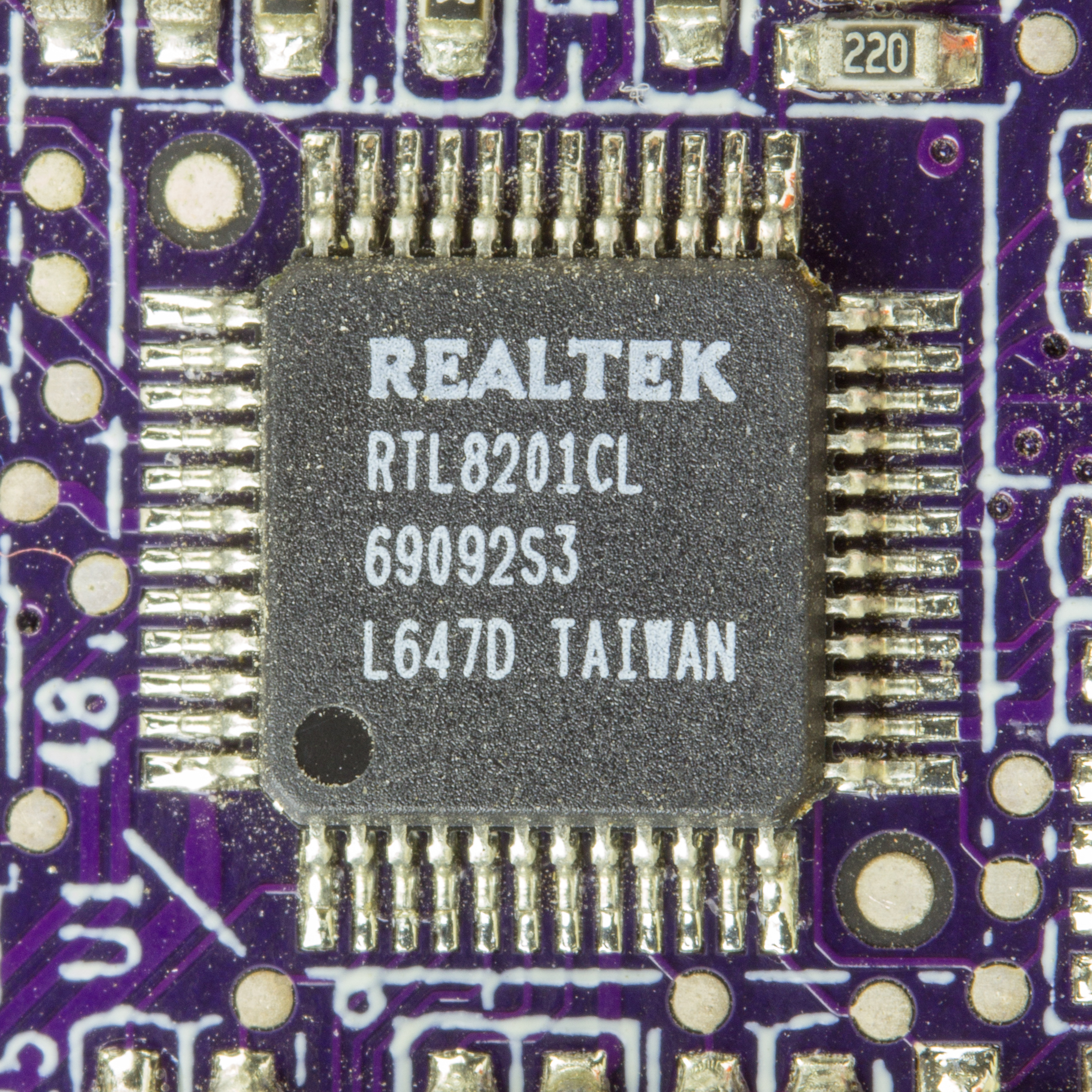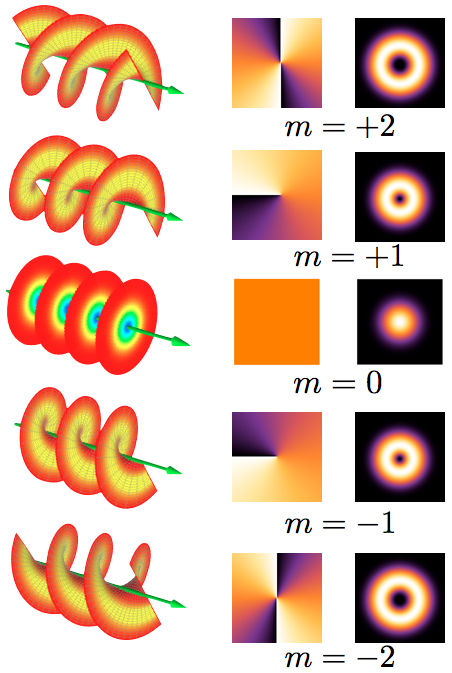|
Orbital Angular Momentum Multiplexing
Orbital angular momentum multiplexing is a physical layer method for multiplexing signals carried on electromagnetic waves using the orbital angular momentum (OAM) of the electromagnetic waves to distinguish between the different orthogonal signals. OAM is one of two forms of angular momentum of light; it is distinct from, and should not be confused with, light spin angular momentum. The latter offers only two orthogonal quantum states, corresponding to the two states of circular polarization, and can be demonstrated to be equivalent to a combination of polarization multiplexing and phase shifting. OAM on the other hand relies on an extended beam of light, and the higher quantum degrees of freedom which come with the extension. OAM multiplexing can thus access a potentially unbounded set of states, and as such offer a much larger number of channels, subject only to the constraint of real-world optics. The constraint has been clarified in terms of independent scattering channe ... [...More Info...] [...Related Items...] OR: [Wikipedia] [Google] [Baidu] |
Multiplexing
In telecommunications and computer networking, multiplexing (sometimes contracted to muxing) is a method by which multiple analog or digital signals are combined into one signal over a shared medium. The aim is to share a scarce resource—a physical transmission medium. For example, in telecommunications, several telephone calls may be carried using one wire. Multiplexing originated in telegraphy in the 1870s, and is now widely applied in communications. In telephony, George Owen Squier is credited with the development of telephone carrier multiplexing in 1910. The multiplexed signal is transmitted over a communication channel such as a cable. The multiplexing divides the capacity of the communication channel into several logical channels, one for each message signal or data stream to be transferred. A reverse process, known as demultiplexing, extracts the original channels on the receiver end. A device that performs the multiplexing is called a multiplexer (MUX), and a ... [...More Info...] [...Related Items...] OR: [Wikipedia] [Google] [Baidu] |
Physical Layer
In the seven-layer OSI model of computer networking, the physical layer or layer 1 is the first and lowest layer: the layer most closely associated with the physical connection between devices. The physical layer provides an electrical, mechanical, and procedural interface to the transmission medium. The shapes and properties of the electrical connectors, the frequencies to transmit on, the line code to use and similar low-level parameters, are specified by the physical layer. At the electrical layer, the physical layer is commonly implemented in a dedicated PHY chip or, in electronic design automation (EDA), by a design block. In mobile computing, the MIPI Alliance *-PHY family of interconnect protocols are widely used. Role The physical layer defines the means of transmitting a stream of raw bits over a physical data link connecting network nodes. The bitstream may be grouped into code words or symbols and converted to a physical signal that is transmitted over ... [...More Info...] [...Related Items...] OR: [Wikipedia] [Google] [Baidu] |
Wavelength-division Multiplexing
In fiber-optic communications, wavelength-division multiplexing (WDM) is a technology which multiplexes a number of optical carrier signals onto a single optical fiber by using different wavelengths (i.e., colors) of laser light. This technique enables bidirectional communications over a single strand of fiber (also called wavelength-division duplexing) as well as multiplication of capacity. The term WDM is commonly applied to an optical carrier, which is typically described by its wavelength, whereas frequency-division multiplexing typically applies to a radio carrier, more often described by frequency. This is purely conventional because wavelength and frequency communicate the same information. Specifically, frequency (in Hertz, which is cycles per second) multiplied by wavelength (the physical length of one cycle) equals velocity of the carrier wave. In a vacuum, this is the speed of light (usually denoted by the lowercase letter, c). In glass fiber, velocity is substan ... [...More Info...] [...Related Items...] OR: [Wikipedia] [Google] [Baidu] |
Vorticity
In continuum mechanics, vorticity is a pseudovector (or axial vector) field that describes the local spinning motion of a continuum near some point (the tendency of something to rotate), as would be seen by an observer located at that point and traveling along with the flow. It is an important quantity in the dynamical theory of fluids and provides a convenient framework for understanding a variety of complex flow phenomena, such as the formation and motion of vortex rings. Mathematically, the vorticity \boldsymbol is the curl of the flow velocity \mathbf v: :\boldsymbol \equiv \nabla \times \mathbf v\,, where \nabla is the nabla operator. Conceptually, \boldsymbol could be determined by marking parts of a continuum in a small neighborhood of the point in question, and watching their ''relative'' displacements as they move along the flow. The vorticity \boldsymbol would be twice the mean angular velocity vector of those particles relative to their center of mass, orie ... [...More Info...] [...Related Items...] OR: [Wikipedia] [Google] [Baidu] |
Optical Vortex
An optical vortex (also known as a photonic quantum vortex, screw dislocation or phase singularity) is a zero of an optical field; a point of zero intensity. The term is also used to describe a beam of light that has such a zero in it. The study of these phenomena is known as singular optics. The concept of "optical vortices" was first described by Coullet et al. in 1989, based on solutions of the Maxwell-Bloch equations. According to one review, studies in 1989-1999 mainly focused on fundamentals; studies in 1999-2009 developed many applications; and studies in 2009-2019 made a number of technological breakthroughs. Explanation In an optical vortex, light is twisted like a corkscrew around its axis of travel. Because of the twisting, the light waves at the axis itself cancel each other out. When projected onto a flat surface, an optical vortex looks like a ring of light, with a dark hole in the center. The vortex is given a number, called the topological charge, according to how ... [...More Info...] [...Related Items...] OR: [Wikipedia] [Google] [Baidu] |
Angular Momentum Of Light
The angular momentum of light is a vector quantity that expresses the amount of dynamical rotation present in the electromagnetic field of the light. While traveling approximately in a straight line, a beam of light can also be rotating (or "''spinning'', or "''twisting'') around its own axis. This rotation, while not visible to the naked eye, can be revealed by the interaction of the light beam with matter. There are two distinct forms of rotation of a light beam, one involving its polarization and the other its wavefront shape. These two forms of rotation are therefore associated with two distinct forms of angular momentum, respectively named light spin angular momentum (SAM) and light orbital angular momentum (OAM). The total angular momentum of light (or, more generally, of the electromagnetic field and the other force fields) and matter is conserved in time. Introduction Light, or more generally an electromagnetic wave, carries not only energy but also momentum, which ... [...More Info...] [...Related Items...] OR: [Wikipedia] [Google] [Baidu] |
RMIT University
The Royal Melbourne Institute of Technology (abbreviated as RMIT University) is a public research university located in the city of Melbourne in Victoria, Australia., section 4(b) Established in 1887 by Francis Ormond, it is the seventh-oldest institution of higher education in Australia, a founding member of the Australian Technology Network (ATN), and a member of Universities Australia (UA). RMIT began as a night school offering classes in art, science and technology in response to the Industrial Revolution in Australia. It was a private college for more than a hundred years before merging with the Phillip Institute of Technology to become a public university in 1992. It has an enrolment of around 95,000 higher and vocational education students. With an annual revenue of around A$1.5 billion. It is ranked 15th in the World for art and design subjects in the QS World University Rankings. The main campus of RMIT is situated on the northern edge of the historic Hodd ... [...More Info...] [...Related Items...] OR: [Wikipedia] [Google] [Baidu] |
Digital Signal Processing
Digital signal processing (DSP) is the use of digital processing, such as by computers or more specialized digital signal processors, to perform a wide variety of signal processing operations. The digital signals processed in this manner are a sequence of numbers that represent Sampling (signal processing), samples of a continuous variable in a domain such as time, space, or frequency. In digital electronics, a digital signal is represented as a pulse train, which is typically generated by the switching of a transistor. Digital signal processing and analog signal processing are subfields of signal processing. DSP applications include Audio signal processing, audio and speech processing, sonar, radar and other sensor array processing, spectral density estimation, statistical signal processing, digital image processing, data compression, video coding, audio coding, image compression, signal processing for telecommunications, control systems, biomedical engineering, and seismology ... [...More Info...] [...Related Items...] OR: [Wikipedia] [Google] [Baidu] |
Fiber-optic Communication
Fiber-optic communication is a form of optical communication for transmitting information from one place to another by sending pulses of infrared or visible light through an optical fiber. The light is a form of carrier wave that is modulated to carry information. Fiber is preferred over electrical cabling when high bandwidth, long distance, or immunity to electromagnetic interference is required. This type of communication can transmit voice, video, and telemetry through local area networks or across long distances. Optical fiber is used by many telecommunications companies to transmit telephone signals, internet communication, and cable television signals. Researchers at Bell Labs have reached a record bandwidth–distance product of over kilometers per second using fiber-optic communication. Background First developed in the 1970s, fiber-optics have revolutionized the telecommunications industry and have played a major role in the advent of the Information Age. ... [...More Info...] [...Related Items...] OR: [Wikipedia] [Google] [Baidu] |
Long-haul Communications
In telecommunications, the term long-haul communications has the following meanings: 1. In public switched networks, pertaining to circuits that span large distances, such as the circuits in inter-LATA, interstate, and international communications. See also Long line (telecommunications) 2. In the military community, communications among users on a national or worldwide basis. ''Note 1:'' Compared to tactical communications, long-haul communications are characterized by (a) higher levels of users, such as the US National Command Authority, (b) more stringent performance requirements, such as higher quality circuits, (c) longer distances between users, including worldwide distances, (d) higher traffic volumes and densities, (e) larger switches and trunk cross sections, and (f) fixed and recoverable assets. ''Note 2:'' ''"Long-haul communications"'' usually pertains to the U.S. Defense Communications System. '' Note 3:'' ''"Long-haul telecommunications technicians"'' can b ... [...More Info...] [...Related Items...] OR: [Wikipedia] [Google] [Baidu] |
Mode Coupling
In the term mode coupling, as used in physics and electrical engineering, the word "mode" refers to eigenmodes of an idealized, "unperturbed", linear system. The superposition principle says that eigenmodes of linear systems are independent of each other: it is possible to excite or to annihilate a specific mode without influencing any other mode; there is no dissipation. In most real systems, however, there is at least ''some'' perturbation that causes energy transfer between different modes. This perturbation, interpreted as an interaction between the modes, is what is called "mode coupling". Important applications are: * In fiber optics * In lasers (compare mode-locking) * In condensed-matter physics, critical slowing down can be described by a Coupled mode theory.{{Cite book , last=Götze , first=Wolfgang , author-link=Wolfgang Götze , url=https://academic.oup.com/book/10864 , title=Complex Dynamics of Glass-Forming Liquids: A Mode-Coupling Theory , date=2008-12-11 , publis ... [...More Info...] [...Related Items...] OR: [Wikipedia] [Google] [Baidu] |





